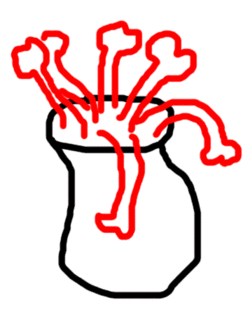User:Bizzeebeever/Articles/Sack Full of Wet Cocks
“[One] should [kneel] passively and try to receive what the painting has to offer, and not bring a subject matter or preconceived idea of what [one] is to be looking for.”
– Jackson Pollock, on Sack Full of Wet Cocks[1]
“I never tire from an eyeful of Pollocks”
Sack Full of Wet Cocks is a seminal work by Jackson Pollock, an influential American painter in the abstract expressionism movement. Completed two years before his death in 1956, Sack Full of Wet Cocks (also known as Girl With a Pearl Necklace) has ever since held a somewhat-disputed niche amongst his greater works. Its original title, No. 69, is preferred by many art purists, for being "more evocative", and "more effective in its descriptiveness."
Composed in yellow, brown, black and white, on a 9'x12' fiberboard laid horizontally during the process, Sack Full of Wet Cocks was painted by Jackson using hardened brushes, tongue depressers, and his own anatomy to apply the characteristic "drip" texture. A documentarian described Pollock's method:
| “ | He was a blur of skin, dipping...[himself] successively in a glorious burnt-umber, a common household eggshell, and a deep jet Brunswick black which smelled acridly, and which caused him to grimace slightly as he applied it...He dove at the surface in an ecstasy of creation, applying [himself] to the canvas over and over...the paint was now literally flowing from his chosen tool onto the canvas.[2] The climactic moment came, and he stepped away from the painting, groaning quietly, 'It is done.' | ” |
Pollock himself said of his curious compositional style, "I feel nearer, more a part of the painting, since this way I can...literally be in the painting....[It is] a natural growth out of a need."[1]
Pollock, dubbed "Jack the Dripper" by Time Magazine, began the painting during a period of his work marked by his obsession with abstracted, disembodied phalluses, a theme which also pervades his other late paintings Easter and the Totem, and Blue Poles. Essayist and art critic Clement Greenberg wrote of viewing Sack Full of Wet Cocks for the first time:
| “ | I was perplexed by the arrangement of the spatters to the upper right of the painting, but then Pollock was kind enough to rotate it.
The gleam in his eye assured me he was pleased by the shock on my face. At that moment, he was as a gleeful schoolboy who has scribbled a particularly choice profanity in a public place, and is revelling in the shock that it brings to others. |
” |
Many modern critics have remarked on the painting's power to move.
Critical Response[edit | edit source]
Over the years, Sack Full of Wet Cocks has polarized commentators even more thoroughly than Pollock's painting style. "Its depth is unplumbable by the eye," enthused Harold Rosenberg. "It is an event, not a painting. Its ineffable substance puts one in mind of an early Sobel, or a disordered Monet. It shines, it glistens with the energy of its progenitor. Itguuuuuhhhhamina..." (Note: Rosenberg's essay ends rather abruptly at that point.)
Robert Coates, however, famously gave the painting its better-known appellation. "It is merely an explosion of random colors," he wrote in 1961, "resembling nothing so much as a sack full of wet cocks. It is such a ludicrous jape to push this painting as art that I suspect the enthusiasm exhibited for it to be a devious sham, orchestrated by an American intelligence agency in an attempt to force American avant-gardism to the forefront." Most critics were dismissive of Coates's comments, referring to him as a "kook" and a "pompous, footling Communist", and were not the least surprised when he disappeared without a trace.
"I won't even dignify Coates's comments by responding to them," wrote Rosenberg, in the New Yorker. "It is obvious that his puerile fascinations have no bearing on the art world."
In 2005, "No. 5, 1948", another of Pollock's paintings, become the most expensive painting ever sold at auction, rumored to have fetched $140 million. Sack Full of Wet Cocks soon surpassed this figure by more than double, the ardor with which it was sought surprising many in the art world.
Footnotes[edit | edit source]
- ↑ 1.0 1.1 An actual, real Jackson Pollock quote. Highbrow, folks.
- ↑ Italicized phrase quoted verbatim et literatim from Jackson Pollock, Wikipedia.

